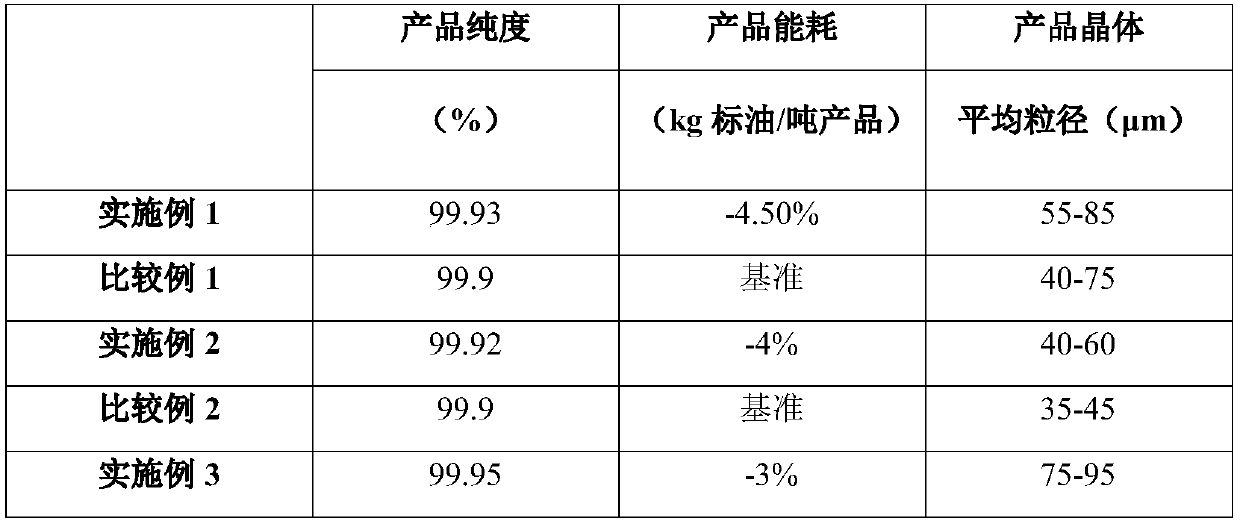Method for purifying crude 2,6-naphthalic acid
A naphthalene dicarboxylic acid and naphthalene dicarboxylic acid slurry technology, applied in the separation/purification of carboxylic acid compounds, bulk chemical production, organic chemistry, etc., can solve a large number of solid absorbents and solvents, separation difficulties, and insufficient optimization of operating conditions, etc. problems, to achieve the effect of reducing the amount of solvent circulation, simplifying the process, and reducing energy consumption of the system
- Summary
- Abstract
- Description
- Claims
- Application Information
AI Technical Summary
Problems solved by technology
Method used
Image
Examples
Embodiment 1
[0034]The crude 2,6-NDCA has a purity of 90%, using supercritical water and acetic acid as a solvent, wherein the acetic acid content is 15%, the concentration of the slurry produced by the crude 2,6-NDCA in the mixing step is 18%, and dissolved The temperature in tank A is maintained at 410°C and 45MPa, and the dissolved slurry passes through the crystallization units in sequence. Each crystallization process lasts for 60 minutes. Four crystallization units in series are used to carry out the process. In the case of four crystallization units B in series , set their temperature and pressure as: set their temperature and pressure as: 350°C and 20MPa in the first crystallization unit, 285°C and 9MPa in the second crystallization unit C, and 285°C and 9MPa in the third crystallization unit 245°C and 5MPa, 200°C and 3.5MPa in the fourth crystallization unit, after crystallization, the product (3) and mother liquor (4) are obtained through the solid-liquid separation unit C, and th...
Embodiment 2
[0039] The crude 2,6-NDCA has a purity of 90%, using supercritical water and isopropanol as a solvent, wherein the content of isopropanol is 20%, and the concentration of the slurry produced by the crude 2,6-NDCA in the mixing step is 10%, the temperature in the dissolution tank A is maintained at 385°C and 28MPa, and the dissolved slurry passes through the crystallization units in sequence, and each crystallization process lasts for 60 minutes. The process is carried out by using 3 crystallization units B connected in series. When the units are connected in series, set their temperature and pressure as: 315°C and 15MPa in the first crystallization unit, 280°C and 9MPa in the second crystallization unit, and 315°C and 9MPa in the third crystallization unit 230°C and 3MPa in the crystallization unit, after crystallization, the product and mother liquor are obtained through the solid-liquid separation unit C, part of the mother liquor is discharged from the system (6), and part o...
Embodiment 3
[0043] The purity of 2,6-NDCA is 98.5%, using supercritical water, the concentration of the slurry produced in the mixing step of crude 2,6-NDCA is 18%, the temperature in the dissolution tank A is maintained at 430°C, 45MPa, and dissolved The final slurry passes through the crystallization unit successively, and each crystallization process lasts 60 minutes. Use 5 crystallization units in series to carry out the process. In the case of 5 crystallization units B in series, their temperature and pressure are respectively set as : Set their temperature and pressure as: 370°C and 25MPa in the first crystallization unit, 300°C and 12MPa in the second crystallization unit, 245°C and 5MPa in the third crystallization unit, 200°C and 200°C in the fourth crystallization unit 3.5MPa. After crystallization, the product (3) and mother liquor (4) are obtained through the solid-liquid separation unit C. The ratio of the mother liquor (6) discharged from the system to the mother liquor (5) r...
PUM
| Property | Measurement | Unit |
|---|---|---|
| purity | aaaaa | aaaaa |
Abstract
Description
Claims
Application Information
 Login to View More
Login to View More - R&D
- Intellectual Property
- Life Sciences
- Materials
- Tech Scout
- Unparalleled Data Quality
- Higher Quality Content
- 60% Fewer Hallucinations
Browse by: Latest US Patents, China's latest patents, Technical Efficacy Thesaurus, Application Domain, Technology Topic, Popular Technical Reports.
© 2025 PatSnap. All rights reserved.Legal|Privacy policy|Modern Slavery Act Transparency Statement|Sitemap|About US| Contact US: help@patsnap.com


